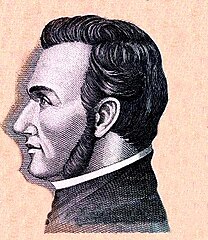Francisco Morazán
 | |
| Data i miejsce urodzenia | 3 października 1792 |
|---|---|
| Data i miejsce śmierci | |
| Prezydent Zjednoczonych Prowincji Ameryki Środkowej | |
| Okres | od 1830 |
| Poprzednik | José Francisco Barrundia |
| Prezydent Salwadoru | |
| Okres | od 1832 |
| Poprzednik | José María Cornejo |
| Następca | Joaquín de San Martín |
| 7. Prezydent prowincji Kostaryka | |
| Okres | od 1842 |
| Poprzednik | |
| Następca | Antonio Pinto Soares |
 | |
Francisco Morazán lub José Francisco Morazán Quesada[1] (ur. 3 października 1792 w Tegucigalpie, zm. 15 września 1842 w San José)[2] – środkowoamerykański polityk pochodzenia honduraskiego, generał, przywódca liberałów, prezydent Zjednoczonych Prowincji Ameryki Środkowej w latach 1830–1835 i 1835–1839. Podjął przy użyciu siły nieudaną próbę powstrzymania rozpadu federacji. Został pojmany i stracony[3]. Bohater narodowy Hondurasu.
Przypisy
- ↑ José Francisco Morazán Quesada. W: Héroes y Proceres [on-line]. www.historiadehonduras.hn, 2009. [dostęp 2014-06-21].
- ↑ Morazán Francisco, [w:] Encyklopedia PWN [online] [dostęp 2014-06-21].
- ↑ Wielka Encyklopedia Polonica. Suplement, Poznań, 2001
Media użyte na tej stronie
Firma del político y militar hondureño Francisco Morazán.
Coat of arms of El Salvador
- The coat of arms has the words (REPÚBLICA DE EL SALVADOR EN LA AMÉRICA CENTRAL) in a bold and Heavy, Sans Serif Boris Black Bloxx typeface, in a golden amber color
- The nacional motto (DIOS UNIÓN LIBERTAD) in bold version of Trajan (typeface), Roman type, Roman square capitals. The letters are colored black within a golden amber scroll.
- The date (15 DE SEPTIEMBRE DE 1821) in bold version of Trajan (typeface), Roman type, Roman square capitals.
Autor: JVC3ETA, Licencja: CC BY-SA 3.0
Francisco Morazan as he Appears in a Honduran 5 Lempiras Bill. Scanned and computerized.



